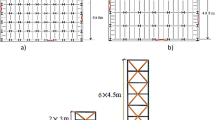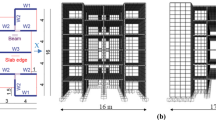Abstract
Supplemental energy dissipation is a technique of earthquake resistant design and for improving the seismic performance of existing buildings. In the present study, a comprehensive design methodology for performance based design of frame buildings with metallic and friction dampers has been proposed. In this study, the target performance level is aimed to achieve both in terms of inter-storey drift and plastic hinge rotation. A non-iterative step-by-step design procedure is proposed to achieve the target performance level. The methodology provides the design yield forces in case of metallic dampers, and slip forces in case of friction dampers. A satisfactory distribution of both types of dampers along the height of the building is also provided in the methodology. The efficiency of the proposed design methodology is validated by applying to a ten storey building and performing nonlinear time history analysis. The building, with and without dampers, is subjected to five spectrum compatible time histories with peak ground acceleration of 0.24 g and the relative performance of the building with the two types of dampers is studied.





Similar content being viewed by others
References
M.L. Bozzo, D. Foti, F. Lopez-Almansa, Design criteria for earthquake resistant buildings with energy dissipators, in Proceedings of 11th World Conference of Earthquake Engineering, vol. 1993 ,Acapulco, Mexico, 1996
S. Fukumoto, Y. Inoue, Effects of characteristics of various inter-storey dampers on response control of vibration of building structures, in Proceedings of 11th World Conference of Earthquake Engineering, vol. 552, Acapulco, Mexico, 1996
S.M.S. Alehashem, A. Keyhani, H. Pourmohammad, Behaviour and performance of structures equipped with ADAS and TADAS (A comparison with conventional structures), in Proceedings of 14th World Conference of Earthquake Engineering, Beijing, 2008
Y. Fu, K. Kasai, Comparative study of frames using viscoelastic and viscous dampers. Struct. Eng. 122(12), 1394–1399 (1998)
I.D. Aiken, D.K. Nims, M. Kelly, Comparative study of four passive energy dissipation systems. Bull. N.Z. Nat. Soc. Earthq. Eng. 25(3), 175–192 (1992)
M.S. Williams, F. Albermani, Evaluation of displacement based analysis and design methods for steel frames with passive energy dissipators, Civil Engineering Research Bulletin No. 24, Department of Civil Engineering, University of Queensland, Brisbane (2003)
S. Lee, J. Park, B. Moon, K. Min, S. Lee, J. Kim, Design of a bracing-friction damper system for seismic retrofitting. Smart Struct. Syst. 4(5), 685–696 (2008)
C. Durucan, M. Dicleli, Analytical study on seismic retrofitting of reinforced concrete buildings using steel braces with shear link. Eng. Struct. 32, 2995–3010 (2010)
M.R. Tabeshpour, H. Ebrahimian, Seismic retrofit structures using friction dampers. Asian J. Civ. Eng. (Build. Hous.) 11(4), 509–520 (2010)
A. Filiatrault, S. Cherry, Seismic design spectra for friction damped structures. Struct. Eng. 116, 1334–1355 (1990)
Y. Fu, S. Cherry, Design of friction damped structures using lateral force procedure. Earthq. Eng. Struct. Dyn. 29, 989–1010 (2000)
Y.Y. Lin, M.H. Tsai, J.S. Hwang, K.C. Chang, Direct displacement-based design for building with passive energy dissipation systems. Eng. Struct. 25, 25 (2003)
R. Vargas, M. Bruneau, Seismic design of multi-storey buildings with metallic structural Fuses, in Proceedings of 8th U.S. National Conference on Earthquake Engineering, San Francisco, California, USA, vol. 280, 2006
D.R. Sahoo, S.H. Chao, Performance-based plastic design of buckling-restrained frames. Eng. Struct. 32, 2950 (2010)
A.K. Chopra, R.K. Goel, A modal pushover analysis procedure to estimate seismic demands for buildings. Earthq. Eng. Struct. Dyn. 31, 561 (2002)
X. Lin, P.J. Moss, A.J, Carr, Seismic analysis and design of building structures with supplemental lead dampers, in Proceedings of 12th World Conference of Earthquake Engineering, Auckland, New Zealand, 2000
ASCE 41-06, Seismic Rehabilitation of Existing Buildings, (American Society of Civil Engineers, Reston, 2006)
R.W. Clough, J. Penzien, Dynamics of structures (McGraw-Hill, New York, 1993)
ATC-40 Vol. 1, Seismic Evaluation and Retrofit of Concrete buildings-Vol. 1 (Applied Technology Council, Redwood City, 1996)
F. Sadek, B. Mohraz, A.W Taylor, R.M. Chung, Passive energy dissipation devices for seismic application, U.S. Department of Commerce, National Institute of Standards and Technology, NISTIR 5923 (1996)
IS: 800, General Construction in Steel Code of Practice, Third Revision.(Bureau of Indian Standards, New Delhi, 2007)
ASCE/SEI 7-05, Minimum Design Loads for Buildings and Other Structures (American Society of Civil Engineers, New York, 2005)
P. Halder, Y. Singh, Seismic performance and vulnerability of indian code designed RC frame building. ISET J. Earthq. Eng. 46, 24–45 (2010)
SAP 2000, Linear and Nonlinear Static and Dynamic Analysis and Design of Three-dimensional Structure, vol. 8.0 (Computers and Structures, Inc., Berkeley, 2002)
X. Lin, P.J. Moss, A.J. Carr, Analysis and seismic design of building structures with supplemental lead dampers, in Proceedings of NZNSEE Conference, Wairakei, Taupo, New Zealand, 167–174, 1998)
V.K. Gupta, S. Mukherjee, Wavelet-based generation of spectrum-compatible time histories. Soil Dyn. Earthq. Eng. 22(1), 799–804 (2002)
IS 456, Indian Standard Plain and Reinforced Concrete Code of Practice(Bureau of Indian Standards, New Delhi, 2006)
IS 1893 Part-1, Criteria for Earthquake Resistant Design of Structures-Part 1 General Provisions and Buildings, Fifth Revision (Bureau of Indian Standards, New Delhi, 2002)
FEMA 356, Pre-Standard and Commentary for the Seismic Rehabilitation of Buildings (Federal Emergency Management Agency, NEHRP, Washington, D.C., 2000)
Author information
Authors and Affiliations
Corresponding author
Rights and permissions
About this article
Cite this article
Chaudhury, D., Singh, Y. Performance-based Design of RC Frame Buildings with Metallic and Friction Dampers. J. Inst. Eng. India Ser. A 95, 239–247 (2014). https://doi.org/10.1007/s40030-014-0089-4
Received:
Accepted:
Published:
Issue Date:
DOI: https://doi.org/10.1007/s40030-014-0089-4




